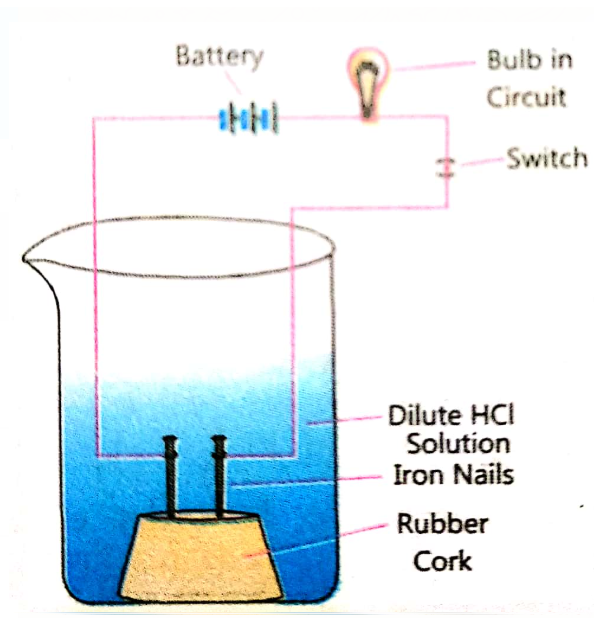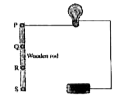How many statement (s) is /are correct ?
(a) Human body conducts electricity .
(b) Cork , safety pin and mica are examples of insulators .
(c ) If both the terminals of the battery are connected to the bulb , bulb glows .
To determine how many statements are correct, we will analyze each statement one by one.
Step 1: Analyze Statement A
Statement A: "Human body conducts electricity."
- The human body is made up of water and electrolytes, which can conduct electricity. Therefore, this statement is correct.
Step 2: Analyze Statement B
Statement B: "Cork, safety pin, and mica are examples of insulators."
- Cork and mica are indeed insulators, as they do not allow electricity to flow through them. However, a safety pin is typically made of metal, which is a conductor, not an insulator. Therefore, this statement is incorrect.
Step 3: Analyze Statement C
Statement C: "If both the terminals of the battery are connected to the bulb, the bulb glows."
- For a bulb to glow, it must be part of a complete circuit. Connecting both terminals of a battery to a bulb does create a circuit, allowing current to flow through the bulb. Therefore, this statement is correct.
Conclusion
- Statement A is correct.
- Statement B is incorrect.
- Statement C is correct.
Thus, 2 statements are correct (A and C).
---
Statement A: "Human body conducts electricity."
Statement B: "Cork, safety pin, and mica are examples of insulators."
Statement C: "If both the terminals of the battery are connected to the bulb, the bulb glows."
- Statement A is correct.
- Statement B is incorrect.
- Statement C is correct.
Topper's Solved these Questions
- ELECTRICITY AND CIRCUITS BOOK - MTG IIT JEE FOUNDATIONCHAPTER - ELECTRICITY AND CIRCUITS EXERCISE - OLYMPIAD /HOTS CORNER
15 Videos
- ELECTRICITY AND CIRCUITS BOOK - MTG IIT JEE FOUNDATIONCHAPTER - ELECTRICITY AND CIRCUITS EXERCISE - EXERCISE (Subjective Problems (Long Answer Type)
5 Videos
- FUN WITH MAGNETSBOOK - MTG IIT JEE FOUNDATIONCHAPTER - FUN WITH MAGNETSEXERCISE - Olympaid/HOTS Corner
15 Videos
Similar Questions
Rahu, is studying in clas X whereas his younger brother Mohan is a student of clas VI. Mohan has been asked by his teacher to make a working model to show that some non-metal can also be a good conductor of electricity. Mohan has already made an electric circuit by using a dry cell whose both the terminals are connected to two long copper wires having crocodile clips attached to their ends, and one of the copper wires has a torch bulb connected in it through a bulb holder. Mohan, however failked to get a non-metal which could conduct electricity. Mohan asked his brother for help. Rahul told Mohan to take a pencil, sharpen this pencil at both ends, and then connect it in the circuit made by him attaching the two crocodile clips at its two ends. Mohan did the same. As soon as the pencil sharpened at both ends was connected in the circuit the torch bulb started glowing.
(a) Of what substance is theblack core of pencil made? What does the glowing of bulb in this activity indicate?
(b) Name the element of which the above substance is anallotrope?
(c) Which allotrope of this element:
(i) is used in glass cutters?
(ii) is used in luibricating oils?
(iii) has a spherical molecule made up of 60 atoms?
(d) Name two properties of this element due to which it forms a large number of compounds.
(e) Name one compound each of this element which is used:
(i) as a solvent.
(ii) to ripen raw fruits
(iii) to preserve are displayed by Rahul in this episode?
View SolutionConsider the ions : S2O2−3(X) and S2O2−4(Y). How many statements are correct regarding (X) and (Y).(d stands for bond length) ds−s:X<Y
(b) ds−o:X<Y
( c) Average oxidation state of S in (X) is less than that in (Y).
(d) In both (X) and (Y), the central S atom is sp3 hybridised.
View Solution
Knowledge Check
In an attemp to demonstrate electrical conductivity through an electrolyte, the apparatus set up is given. Which among the following statement (s) is (are) correct ?

(i) Bulb will not glow because electrolyte is not acidic
(ii) Bulb will glow because HCl is strong acid and furnishes ions for conduction.
(iii) Bulb will not glow because circuit is incomplete
(iv) Bulb will not glow because it depends upon the type of electrolytic solutionA(i) and (iii)B(ii) and (iv)COnly (ii)DOnly (iv)In an attempt to demonstrate electrical conductivity through an electrolyte, the apparatus set up is given. Which among the following statement (s) is (are) correct ?

(i) Bulb will not glow because electrolyte is not acidic
(ii) Bulb will glow because HCl is strong acid and furnishes ions for conduction.
(iii) Bulb will not glow because circuit is incomplete
(iv) Bulb will not glow because it depends upon the type of electrolytic solutionA(i) and (iii)B(ii) and (iv)C(ii) onlyD(iv) onlyWhich of the following given statements is/are correct?
(a) cold cream is an example of (W/O) type emulsions,
(b)electrical conductance of aqueous emulsions is less than that of oil emulsions
(c) emulsions cannot be broken into constituent liquids by heating or freezing
(d) an emulsion can be diluted with water, then it forms (O/W) type emulsionA(a) and (d)Bonly (a)C(a), (b) & (c)D(a) ,(c) & (d)
Robert constructs an electrical circuit as shown in the given fgure. Four different points are labeled as P, Q, R, and S on the wooden rod.

In the given circuit, the bulb will glow when the positive terminal of the battery is connected to the point
View SolutionHow many of the following statement(s) is/are incorrect w.r.t. Periplaneta?
(a) Embryonically, the body is made of 20 segments which reduce to 14 in adults
(b) Body part with unchanged number of segments throughout life cycle is thorax
(c) Anal styles are 15 segmented appendages of male cockroaches
(d) Anal cerci are unsegmented appendages of both male and female cockroaches
View SolutionA particle of charge +q and mass m moving under the influence of as uniform electric field Eˆi and uniform magnetic field Bˆk follows trajectory form P to Q as shown in figure. The velocities at P and Q re vˆiand−2ˆj. Which of the following statement(s) is/are correct?

a.E=34[mv2qa]
b. Rate of work done by the electrif field at P is 34[mv3a]
c. Rate of work done by the electric field at P is zero.
d. Rate of work done by both the field at Q is zero.
View SolutionHow many statement is/are correct regarding flat worms? (a) Cysticercosis in man is caused by ingestion of cysticercus in measly pork (b) Fasciola enter snarl's body at miracidium stage and leave it at metacercana stage. (c) All flat worms are hermaphrodite and they exhibit cross fertilisation. (d) Nervous system in Dugesia has only 1-3 longitudinal nerve cords connected by transverse commissure. Cerebral ganglia is absent
View SolutionAn electric circuit is set up in such a way that the positive terminal of a battery V is connected to a bulb B1 which is connected to a resistor R which is connected to bulb B2.B2 is finally connected to the negative terminal of the battery. Both the bulbs are glowing. If the value of R is increased, then
View Solution
